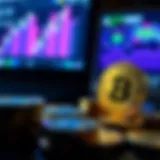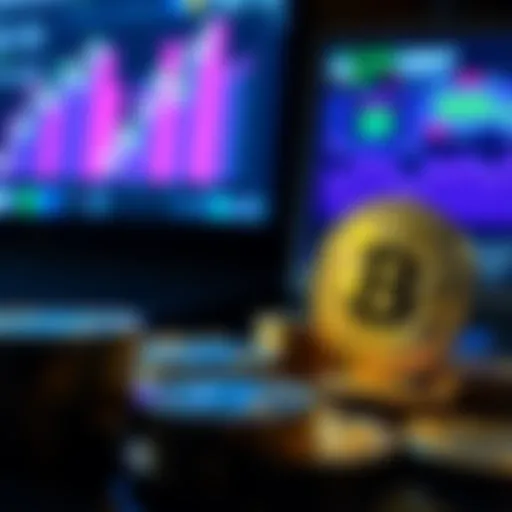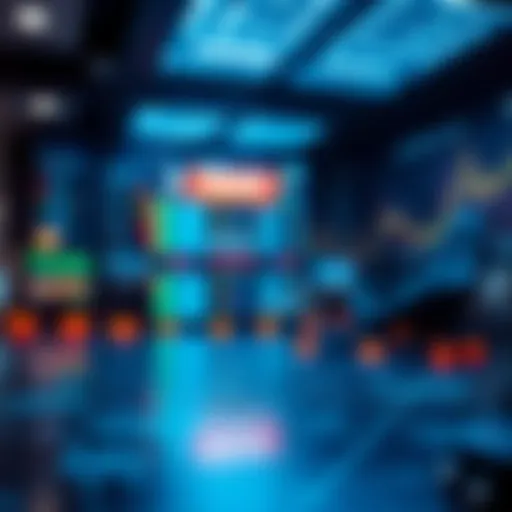Understanding NFT Art: A New Frontier in Creativity
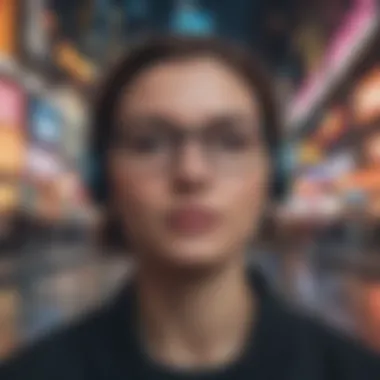

Intro
As we step into a world where technology and creativity meld into one cohesive narrative, NFT art emerges as a significant player, capturing the minds of a diverse audience. Artists, collectors, and tech enthusiasts alike are finding themselves entangled in this novel scene that offers a new channel for expression, investment, and ownership. NFTs, or non-fungible tokens, act as digital signatures on the blockchain, ensuring that each piece of art is one-of-a-kind and traceable.
What drives this phenomenon? Is it the thirst for innovation or merely a financial gamble? This exploration aims to dissect the multiple layers of NFT art, ultimately aiming to provide clarity on its role within the current art and technology landscape.
Understanding Cryptocurrency Fundamentals
To understand NFT art, one must first grasp the basics of cryptocurrency and blockchain technology. These elements act as the backbone of how NFTs function.
Key Concepts of Blockchain Technology
The blockchain operates much like a public ledger, documenting every transaction in a way that is transparent yet secure. The major ideas include:
- Decentralization: Unlike banks, no central authority controls the data on the blockchain.
- Immutability: Once data is recorded on the blockchain, it cannot be altered or erased, providing a permanent record.
- Transparency: Anyone can view the transactions happening in real-time, contributing to a sense of trust and accountability.
This transparency is essential for artists and collectors. It allows them to verify provenance, ensuring that each piece of NFT art can be traced back to its original creator.
Types of Cryptocurrencies and Their Uses
While Bitcoin often steals the spotlight, there exists a whole cornucopia of cryptocurrencies, each with its unique purpose. For instance:
- Ethereum: The most widely used platform for creating NFTs, supporting complex contracts and decentralized applications.
- Litecoin: Offers faster transaction times and is often dubbed the silver to Bitcoin's gold.
- Ripple: Primarily aimed at facilitating currency exchange and remittances efficiently.
These cryptocurrencies form the infrastructure that supports NFT transactions, allowing both buyers and sellers to engage in a vibrant marketplace.
Analyzing Market Trends
Understanding market momentum is key, especially where the rapid evolution of NFT art is concerned. As more people enter this realm, it’s crucial to keep an eye on underlying trends.
Tools and Techniques for Market Analysis
A variety of tools can aid in assessing the NFT market landscape. Some can be tricky to navigate:
- CryptoSlam: Provides real-time data on NFT sales and collections.
- Nansen: Offers insights into wallet movements and trends in various NFT projects.
- Dune Analytics: Enables users to create custom queries and dashboards for specific NFT markets.
Employing such tools helps illuminate the buyer and seller behaviors, assisting in identifying profitable opportunities.
Identifying Emerging Trends in Crypto Investing
As an investor, recognizing nascent trends can set one apart from the crowd. Some recent phenomena include:
- The rise of virtual galleries, providing a platform for artists to showcase their digital works.
- Increasing collaborations between traditional artists and tech companies, further blurring the lines across creative mediums.
- The environmental concerns surrounding blockchain, prompting some artists to seek eco-friendly solutions.
"The NFT space is evolving rapidly—what's hot today might be old news tomorrow."
By staying informed and adapting to the ever-shifting landscape, investors can seize opportunities that may otherwise go unnoticed.
Preamble to NFT Art
In recent years, no topic has stirred conversation across art circles and investment forums alike quite like non-fungible tokens, often referred to as NFT art. The topic occupies a prominent space in the intersection of creativity and technology, shaping new paradigms. Understanding NFT art is essential not just for art enthusiasts, but also for those looking to invest, trade, or simply explore the burgeoning field of digital commodities.
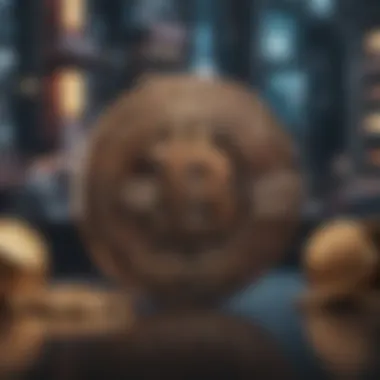

Defining NFT Art
NFT art can be defined as unique digital assets that exist within the blockchain, acting as a certificate of authenticity for artworks. Unlike traditional art objects, which can be duplicated or reproduced, NFTs ensure each digital piece is one of a kind. They are revolutionizing how we perceive ownership in the art world. This shift is aptly described as changing the game of collecting. Much like a limited print run of a photograph, NFT art asserts its rarity in a realm where digital duplication has been the norm.
"NFTs breathe new life into the concept of ownership, giving digital artists the tools to secure their work in ways previously thought impossible."
Historical Context
To understand the significance of NFT art, we must first step back in time. The roots of digital art can be traced to the early days of computer graphics, when artists began exploring new mediums. Fast forward to the late 2000s and early 2010s, digital art blossomed into various forms and gained significant traction. However, the concept of ownership remained a challenge until blockchain technology emerged. The launch of Cryptokitties in 2017 marked a watershed moment, introducing many to the world of NFTs. This cat-themed game demonstrated the possibilities of owning digital assets on a blockchain, inviting a wave of artists and collectors to dive into the realm of NFTs.
The Role of Cryptocurrency
The relationship between NFT art and cryptocurrency is undeniably intertwined, as the latter often serves as the currency within NFT marketplaces. Ethereum, in particular, has become the backbone for most NFT transactions thanks to its smart contract capabilities. This connection not only facilitates the buying and selling of digital art but also embeds these transactions with unprecedented transparency and security. As users trade NFT art, cryptocurrency serves as both the medium and the metric, establishing new economic frameworks. However, it’s essential to acknowledge that fluctuating cryptocurrency values can impact an artist's work and its perceived worth, leading to debates around valuation and sustainability in this evolving landscape.
In summary, the introduction to NFT art sets the stage for a deeper understanding of how it redefines both artistic creation and collection in the digital age. As we move through the various aspects of NFT art, from its foundational principles to its implications on cultural and economic fronts, we'll discover the nuanced layers that make this phenomenon worthy of exploration.
Understanding Non-Fungible Tokens
Understanding non-fungible tokens is essential in grasping the essence of NFT art. They are not just digital artifacts; they are verifiable assets at the intersection of art, technology, and economics. Unraveling these tokens sheds light on how artists and collectors interact with digital creations, creating a new paradigm in ownership and provenance. To fully appreciate the NFT art movement, one must delve into the fundamental principles behind these tokens, explore the technological frameworks that support them, and analyze the ever-evolving marketplace dynamics.
Basic Principles of NFTs
Non-fungible tokens, or NFTs, are a unique breed among digital assets. Unlike cryptocurrencies such as Bitcoin or Ethereum, which are fungible and interchangeable, NFTs stand out with their distinctiveness. Each NFT is tied to one specific asset, making it irreplaceable.
At the core of an NFT is its metadata, which includes details such as the owner, transaction history, and description of the asset. This metadata is stored on a blockchain, primarily Ethereum, ensuring a transparent and tamper-proof history of ownership. By having this unique digital fingerprint, an NFT validates the authenticity of a digital item, whether it be art, music, or collectibles.
- Ownership: Owning an NFT means you have a direct claim to the underlying asset.
- Scarcity: Artists can create limited editions or one-of-a-kind pieces, enhancing their value.
- Transferability: NFTs can be bought, sold, or traded in various marketplaces, facilitating a dynamic ecosystem.
NFTs have unlocked new doors for creators and innovators, making the digital realm as viable as traditional art markets. Artists now experience a greater sense of control over their work, enabling direct sales to their audience without intermediaries.
Technological Framework of NFTs
The backbone of NFTs is blockchain technology—a decentralized ledger that records transactions across many computers in a way that prevents alteration. Ethereum is the leading blockchain for NFTs, offering an established network where creators can launch their tokens. The ERC-721 standard is a commonly used framework that facilitates the creation of NFTs by providing a set of rules for them to follow.
The concept of smart contracts plays a critical role here. Smart contracts are self-executing contracts with the terms of the agreement directly written into code. This promotes trust and transparency since these contracts automatically execute when conditions are met. For NFT creators, smart contracts can include clauses for royalties, ensuring artists earn a percentage from future sales of their work.
- Decentralization: Removes the need for a central authority in transactions.
- Immutability: Once data is written to the blockchain, it cannot be altered, ensuring trust in the ownership history.
- Interoperability: NFTs can be transferred between platforms that support the same blockchain standards, broadening their utility.
Technology has not only enabled the existence of NFTs but also shaped they way we perceive digital ownership and relationships in art.
Marketplace Dynamics
Navigating the NFT marketplace is akin to walking through an art fair, yet with some distinct differences. Platforms like OpenSea, Rarible, and Foundation have emerged, each with its unique features, ranging from ease of use to community engagement. The high-profile sales of NFT works have garnered attention, making headlines with staggering sale prices, thus attracting diverse participants—artists, collectors, and even casual observers.
Marketplaces dynamically shift as they introduce various features that appeal to both new and seasoned users. Here are some key factors driving market dynamics:
- Visible Art: Digital galleries showcase NFTs like traditional art exhibitions, allowing users to browse and discover.
- Community Engagement: Platforms often build communities where collectors and artists interact, fostering a sense of belonging and collaboration.
- Speculation: The hype around NFTs has led to speculative purchasing; people often buy tokens expecting their value to skyrocket.
As the NFT landscape continues to evolve, understanding its marketplace dynamics is essential for anyone engaged in this digital art revolution. With the fusion of art and technology, the discussions around value and culture will undoubtedly grow richer as more people enter this unique ecosystem.
Artistic Implications of NFTs


NFTs have emerged as a transformative force in the art world. The intersection of art and technology is increasingly significant, creating not only a new medium for artists but also alternative paths for revenue and expression. Artists today are rethinking their roles in this elaborate tapestry of digital interaction, fueled by the unique properties of non-fungible tokens. Exploring the implications of NFTs in art unveils a spectrum of opportunities and challenges that can reshape creative practices.
Empowerment of Artists
One of the most notable changes brought by NFTs is the empowerment they offer to artists. By utilizing blockchain technology, artists gain direct access to their audiences without the need for traditional intermediaries like galleries or auction houses. This direct connection has crucial benefits:
- Higher Earnings: Artists can set their own prices and earn royalties on secondary sales, ensuring ongoing financial support as their work appreciates in value. Imagine a digital illustrations selling for just $10 at first, only for it to sell later at $1000 while the creator continues to earn a percentage.
- Greater Control: Creators retain ownership of their digital works, with smart contracts governing the terms of sales and usage. This control allows them to cultivate their brand and protect their intellectual property more effectively.
- Diverse Mediums: NFT art isn't confined to one form. From digital paintings to interactive installations, artists can experiment with mixed media and reap the benefits of various styles in the space.
In this evolving landscape, the artists’ power grows, fostering creativity that challenges traditional boundaries.
Changing Notions of Ownership
Ownership is becoming a complex concept in the NFT realm. Previously, owning a piece of art meant possessing a physical item; however, NFTs shift this perception radically. Now, collectors can own a token that represents an artwork, rather than the image or piece itself.
- Digital Provenance: Each NFT's transaction history is stored on the blockchain, creating a transparent means of verifying the origin and ownership of digital art. This provenance reduces concerns about forgery and enhances collectors' confidence in their purchases.
- Fractional Ownership: Some platforms offer fractional ownership, where multiple people can collectively hold ownership of a single NFT. This opens doors for more individuals to invest in high-value art pieces that might have otherwise been out of reach. It’s like owning a chunk of a priceless painting, allowing more people to engage with art in a financial capacity.
- Cultural Shift: The transition towards owning digital assets primes a shift in how society perceives value in art. As digital artwork becomes more prevalent and accepted, collectors, artists, and even casual admirers redefine what it means to "own" something valuable.
Shifts in Art Production and Consumption
NFTs have also initiated significant shifts in how art is produced and consumed. The need for conventional methods is waning, replaced by innovative approaches that mirror changing consumer behaviors.
- Accessibility: Digital platforms enable artists to showcase their work to a global audience without needing a physical venue. Art can be shared, enjoyed, and traded across borders, breaking down geographic barriers.
- Consumer Engagement: The interactive nature of NFTs allows for deeper engagement. Collectors aren't just passive buyers; they become part of the art experience. They can interact, play, and sometimes even influence the artwork itself. This participatory aspect captures a more active type of fandom.
- Dynamic Art: Artists can create works that evolve over time or react to external variables, such as the environment or viewer interactions. This notion of dynamic art elevates the experience beyond viewing into an immersive journey.
As the landscape of art continues to evolve amid these shifts, both creators and consumers must navigate these new waters carefully, striving for balance while pushing the boundaries of creativity, ownership, and value.
"The joy of art is its ability to connect people—and with NFTs, those connections take new, exciting forms that could enrich the entire ecosystem of art appreciation."
Cultural and Economic Impact
The cultural and economic impact of NFT art is profound, reshaping how we view creativity and ownership. It blurs the lines between artistic expression, commerce, and technology, necessitating a deeper understanding of how these elements interact. NFT art catalyzes discussions about value, accessibility, and the very nature of art. As these tokens become fixtures in both digital and physical realms, it’s crucial to consider the implications for artists, collectors, and the market at large.
Integrating NFTs with Traditional Art Frameworks
Integrating NFTs into traditional art frameworks presents both challenges and opportunities. Many galleries and art organizations are starting to embrace the potential these digital assets offer. For instance, established institutions like the Louvre are increasingly showcasing digital art alongside classical pieces. This fusion invites a broader audience to appreciate art in new formats.
- The integration does not replace traditional art but enhances it by offering an additional layer of interaction.
- Artists can display their work in virtual galleries, attracting tech-savvy collectors who might not engage with physical artworks.
- This shift raises questions about authenticity and provenance, pushing galleries to innovate and rethink display strategies.
However, integrating NFTs also comes with its own set of hurdles. Traditionalists often argue that the experience of viewing art in a physical space can’t be replicated online. There’s resistance regarding how NFTs fit within well-established norms of curation and exhibition. Striking a balance between these opposing forces is key to fostering a more inclusive art environment.
New Economic Models for Art Sales
NFTs are revolutionizing the economics surrounding art sales, ushering in models that directly benefit artists and collectors. With the prior market structure heavily favoring galleries and auction houses, NFTs flip the script by facilitating direct transactions between artists and their audience. This democratization of the market is monumental.
- Artists can sell their work in various ways; through auctions, fixed-price sales, or even fractional ownership. This flexibility caters to different collectors and opens up new revenue streams.
- Additionally, smart contracts ensure that artists receive royalties on secondary sales, maintaining their connection to the artwork even after initial purchase.
- Curators and platforms are also exploring subscription models, allowing patrons to access a rotating collection of digital art.
These new economic models are creating a landscape where creativity is more financially sustainable. Artists can now reach global audiences without the traditional barriers of entry. However, this shift prompts a need for new marketing strategies and engagement practices tailored to digital interactions.
Global Reach and Accessibility
The advent of NFT art breaks down geographical barriers, granting artists a platform to reach an international audience. This global reach is unheard of in traditional art markets, where location often dictates access and exposure. Through NFTs, an artist in a small town can sell their work to a collector in another part of the world with just a click.
This increase in accessibility has several implications:
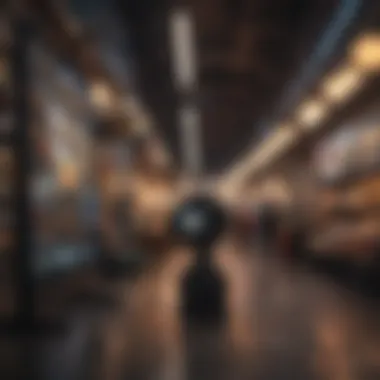

- Diversity in Artistic Voices: With platforms catering to varied styles and mediums, we now see a more diverse group of artists gaining recognition. Those whose work might not have been traditionally showcased in major galleries can find their niche in the digital realm.
- Lower Barriers to Entry: For many emerging creators, the costs associated with physical exhibitions and galleries can be prohibitive. NFTs lower these costs, allowing anyone to showcase their work and potentially earn a living.
- Education and Awareness: The rise of NFT art has led to educational initiatives focused on digital literacy, helping both artists and collectors understand this new paradigm. This collective learning contributes to a more informed and innovative art community.
Critiques and Controversies
The emergence of NFT art has not been all about innovation and enthusiasm. It’s also sparked a firestorm of critiques and controversies that cannot be overlooked. Conversations swirling around environmental impacts, copyright issues, and debates about authenticity and value are vigorous and essential for any serious discussion on NFT art. Understanding these critiques offers insights into the challenges that accompany novelty, raising questions that investors, artists, and collectors alike must consider as they navigate this dynamic landscape.
Environmental Concerns
NFTs predominantly exist on blockchain technologies, many of which use a proof-of-work model. This model requires substantial computational power, leading to heavy energy consumption. The debate over the environmental footprint of NFTs often feels like a tug of war; on one side, proponents praise the democratization of art and ownership through digital means, but on the other, critics point to the carbon emissions generated by these transactions.
For instance, the Ethereum network, which hosts a significant volume of NFT transactions, has been scrutinized for its energy-intensive mining process. As highlighted in discussions on platforms like reddit.com, some artists are now seeking alternative blockchains that prioritize sustainability, such as Tezos or Flow. 🚫🌍 The implication of these concerns is deafening: as the NFT market continues to bloom, so does the responsibility to adopt greener practices in technology.
Issues of Copyright and Plagiarism
Another layer of complexity in the NFT arena involves copyright disputes and allegations of plagiarism. The allure of transforming digital art into NFTs has propelled some artists into an ethical gray zone. Unauthorized reproductions or minting of others' work as NFTs without permission has caused considerable backlash. One can easily see how the convenience of digital space can lead to misunderstandings or, worse, infringement.
The case of artists like Grimes and Beeple, who have both found immense success in the NFT space, illustrates the fine line that exists between inspiration and theft. A blockquote from a legal expert on britannica.com captures this well:
"The digital realm is fraught with challenges regarding ownership; the NFT does not automatically confer copyright."
This brings up pressing questions on how current copyright law applies to NFTs. As new frameworks emerge, artists will need to navigate these murky waters carefully to protect their creative rights without stifling innovation.
Debates over Value and Authenticity
Lastly, the discussions surrounding value and authenticity in the world of NFT art rival those of the oldest and most established art markets. In traditional contexts, artists' reputations and historical significance influence the valuation of art. NFTs, however, introduce different variables that challenge old paradigms. The sheer volatility in pricing for digital artwork, often based on speculative trends, raises eyebrows.
Some might wonder, how does one place a value on digital art that is, by nature, reproducible? Can a JPEG or GIF ever carry the same weight as a canvas crafted by a known master? The ongoing debates have spurred critics to question what it truly means for something to be authentic in the digital age.
The authenticity markers employed within NFTs, such as metadata and blockchain records, are designed to reassure buyers, yet skeptics continue to question their sufficiency. The art world must grapple with this shifting definition of value in a way that respects both tradition and innovation.
The Future of NFT Art
The future of NFT art stands as a compelling junction between technology, creativity, and economy. Understanding this future isn’t just for artists or collectors; it’s essential for investors and enthusiasts who are keen on navigating this evolving landscape. As digital methodologies continue to shape artistic expression, it’s vital to consider how emerging elements might redefine the functioning of the art world.
Emerging Trends
In recent years, several trends have emerged that are poised to shape the trajectory of NFT art in significant ways. One such trend is the integration of augmented reality (AR) and virtual reality (VR) within NFT platforms. Artists are increasingly experimenting with AR and VR to create immersive experiences that appeal to tech-savvy consumers. Moreover, NFTs are not static anymore—they are evolving. You might find that the concept of dynamic NFTs is gaining traction, where the artwork itself can change over time, perhaps reflecting real-world events or evolving based on user interactions.
Also noteworthy is the move towards community-driven projects. Artists and collectors now collaborate to create NFT art that resonates more deeply with specific communities. This could shift purchasing from individual artists to collective ownership models, enabling fans to invest jointly in artworks they cherish. The NFT space might become more like a gallery where artists and supporters mingle, breaking down walls that traditionally kept buyers and creators apart.
Potential for Cross-Disciplinary Collaborations
Cross-disciplinary collaborations are another exciting frontier. The fusion of various fields—like technology, traditional art forms, and even science—can catalyze innovative artistic practices. For instance, artists might join forces with coders to develop interactive pieces that incorporate artificial intelligence, enhancing the depth of engagement. Couplings between visual arts and musical NFTs demonstrate how sound can serve as a complementary element to visual works, creating richer experiences.
Furthermore, the involvement of fashion designers within the NFT realm illustrates yet another cross-pollination. Fashion brands are embracing NFTs to offer digital garments and accessories, allowing consumers to style their virtual avatars in unique ways. This might spearhead a cultural shift in what fashion means—no longer just confined to the material, but extending into the digital.
Regulatory Landscape
As NFT art continues to evolve, so does the regulatory framework surrounding it. Navigating this landscape is crucial for artists and investors alike. Currently, the regulatory environment is often unclear, with existing laws struggling to keep pace with technological advancements. More and more, the discussion around intellectual property rights, market transparency, and consumer protection is gaining momentum.
"The regulatory landscape for NFT art is a double-edged sword; it presents challenges while also prompting the establishment of protective measures for creators and buyers alike."
One area to watch is taxation on NFT transactions. As more jurisdictions establish guidelines, there will be crucial implications for how sales are taxed and reported. Furthermore, issues related to copyright protections are critical; creators need assurance that their works won’t be misappropriated in the fast-paced online marketplace. It will be essential for stakeholders to keep an eye on legislative developments, as they can easily affect the legitimacy, safety, and profitability of NFT art transactions.












